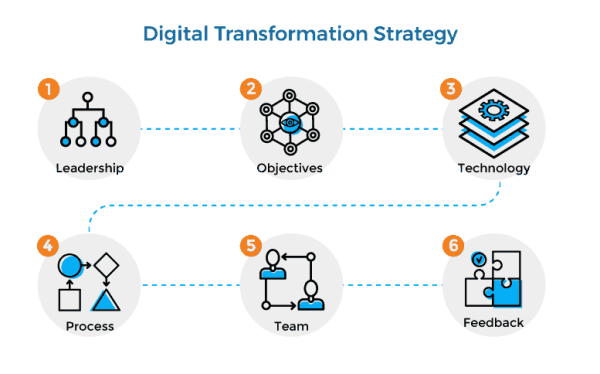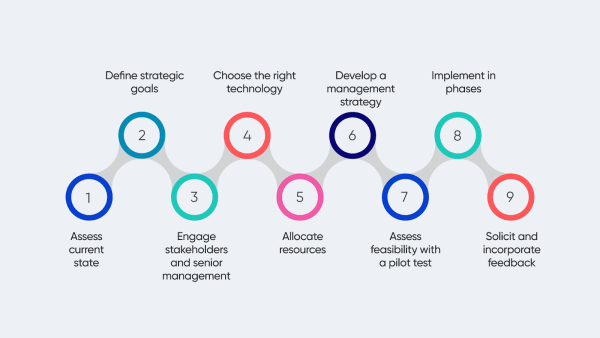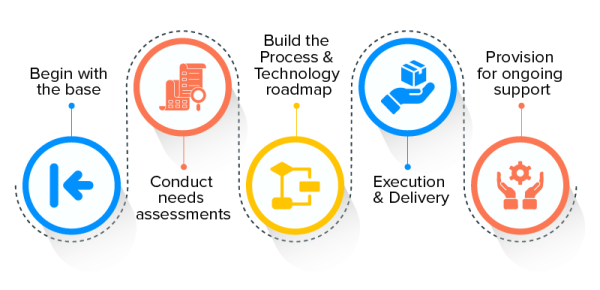Developing a Successful Digital Transformation Strategy in Healthcare

The healthcare landscape is undergoing a seismic shift driven by technological advancements. This digital revolution, known as digital transformation, is fundamentally changing how healthcare organizations function and connect with patients.
This guide serves as a roadmap for navigating the complexities of developing and implementing a winning digital transformation strategy in healthcare. We’ll answer the question “What is digital transformation strategy” and explore the advantages, potential roadblocks, and best practices associated with this transformative journey.
1. What Is A Digital Transformation Strategy?
A digital transformation strategy is a comprehensive plan that completely reshapes how your organization works, delivers value and fosters a culture of innovation. This means integrating digital tools and processes into everything you do, from patient care and clinical practices to administrative tasks and data management.

This strategy should address questions like:
- What are our current challenges and opportunities?
- How can technology help us improve patient care?
- What digital tools and resources do we need to invest in?
- How will we integrate new technologies with existing systems?
- How will we train staff and ensure the successful adoption of new technologies?
1.1. Why is it so important in healthcare?
The healthcare industry faces a unique set of hurdles. Costs are rising, patients have higher expectations, and there’s a constant push for better outcomes. A well-defined digital transformation strategy is your key to:
- Enhance patient care and experience: Streamline appointment booking, offer remote care options, and provide patients with secure access to their medical records.
- Streamline operations and reduce costs: Automate administrative tasks, improve efficiency in resource allocation and potentially reduce costs associated with redundant processes.
- Improve data-driven decision-making: Leverage data analytics to gain insights into patient populations, track performance metrics, and make informed decisions regarding care delivery and resource allocation.
- Ensure compliance with evolving regulations: Stay up-to-date with changing healthcare regulations by implementing digital solutions that support compliance requirements.
- Stay competitive: Embrace technological advancements to remain competitive in a rapidly evolving healthcare landscape.
1.2. Key Components of a Successful Digital Transformation Strategy
Building a successful digital transformation strategy requires careful planning and execution. Here are some key components:

- Establish a Clear Vision and Goals: Define your desired future state for healthcare delivery within your organization. Set specific, measurable, achievable, relevant, and time-bound (SMART) goals aligned with this vision.
- Assess Current State and Identify Gaps: Evaluate your current digital capabilities, infrastructure, and processes. Identify areas for improvement and opportunities to leverage technology.
- Engage Stakeholders and Foster Collaboration: Involve all relevant stakeholders, including doctors, nurses, administrators, IT professionals, and even patients. Open communication and collaboration ensure everyone understands the goals and is on board with the transformation.
- Prioritize Initiatives and Develop a Roadmap: Focus on initiatives with the most significant impact on patient care, operational efficiency, and financial sustainability. Create a roadmap outlining the implementation timeline, resource allocation, and how you’ll measure success.
- Select the Right Technology Solutions: Choose technology solutions that align with your specific needs and goals. Consider factors like interoperability (ability to work with existing systems), scalability (ability to handle growth), security, and user-friendliness.
- Implement and Manage Change Effectively: Implement initiatives in phases, with proper training and support for users. Address potential resistance to change and foster a culture that embraces innovation.
- Continuously Monitor and Evaluate: Track the progress of your transformation and evaluate its impact on achieving your goals. Regularly review and adapt your strategy based on new trends, technological advancements, and evolving healthcare needs.
1.3. Challenges in Developing a Digital Transformation Strategy
Developing a digital transformation strategy for healthcare comes with its own set of challenges:
- Legacy systems and outdated infrastructure
- Resistance to change from staff and stakeholders
- Complex regulatory environment
- Limited budgets and resources
- Interoperability issues between systems
- Concerns about data privacy and security

Here’s how healthcare organizations can overcome these hurdles:
- Conduct thorough assessments to understand your current state.
- Engage all stakeholders throughout the planning process.
- Prioritize initiatives based on potential impact and feasibility.
- Implement changes in phases to minimize disruption.
- Invest in robust change management and communication strategies.
By following these steps and addressing the challenges, healthcare organizations can develop a successful digital transformation strategy that paves the way for a more efficient, patient-centered, and future-proof healthcare system.
2. Benefits of Digital Transformation In Healthcare Industry
The healthcare industry is undergoing a transformative shift driven by digital technologies. Healthcare digital transformation companies are emerging to help healthcare providers implement these changes. But how do you develop a digital transformation strategy that delivers real results? Digital transformation offers a comprehensive set of benefits for both patients and healthcare organizations.
>>> See more: Top 5 Digital Transformation Company Leading the Industry 2024
2.1. Improved Patient Care and Experience
At the heart of digital transformation and strategy lies the goal of enhanced patient care and experience. Through innovative technologies and data-driven insights, healthcare providers can deliver more personalized, efficient, and effective care.

- Enhanced Patient Engagement: Patients can take a more active role in their health through patient portals, mobile health apps, and telemedicine platforms.
- Personalized Treatment Plans: Big data, AI, and predictive analytics enable the development of highly personalized treatment plans.
- Streamlined Care Coordination: Electronic health records, secure messaging systems, and care management platforms improve communication and coordination among healthcare providers.
2.2. Enhanced Operational Efficiency
Digital transformation can dramatically improve the operational efficiency of healthcare organizations, leading to cost savings and improved service delivery.

- Automation of Administrative Tasks: Repetitive tasks like appointment scheduling, billing, and inventory management can be automated.
- Optimized Resource Allocation: Advanced analytics and AI can help optimize staffing, equipment utilization, and resource allocation.
- Streamlined Clinical Workflows: Digital documentation, voice recognition, clinical decision support systems, and automated alerts improve clinical workflows.
2.3. Better Decision-Making through Data Analytics
The vast amount of data generated in healthcare settings can be leveraged to improve decision-making at all levels of the organization.

- Clinical Decision Support: Data analytics provide real-time insights to support clinical decision-making.
- Population Health Management: Data analytics enable proactive approaches to population health by identifying trends, targeting interventions, and evaluating program effectiveness.
- Operational Performance Improvement: Data analytics can be used to identify bottlenecks, monitor key performance indicators, and conduct cost-benefit analyses.
2.4. Cost savings and revenue growth
Digital transformation can lead to significant cost savings and create new opportunities for revenue growth.
- Reduced Operational Costs: Automation, improved resource allocation, and predictive maintenance can significantly reduce costs.
- New Revenue Streams: Telemedicine, remote monitoring services, and data monetization create new revenue opportunities.
- Improved Reimbursement: Better documentation, quality improvement initiatives, and reduced readmissions can lead to improved reimbursement rates.
3. How to Develop a Digital Transformation Strategy
Building a successful digital transformation strategy requires a well-defined approach. Here are the crucial steps to follow:

3.1. Conducting a Comprehensive Assessment of the Current State
Before diving in, it’s essential to understand your organization’s current situation. This involves a thorough assessment that identifies strengths, weaknesses, and opportunities for improvement.
- Technology Infrastructure Audit: This audit evaluates your existing hardware, software, and systems, uncovering areas needing upgrades or replacements.
- Process Mapping and Analysis: By mapping out your clinical and administrative processes, you can identify inefficiencies and opportunities for automation.
- Skill Gap Analysis: Assess the digital literacy of your staff to determine if additional training is needed for successful technology adoption.
3.2. Setting Clear Goals and Objectives
With a clear understanding of your current state, you can define specific goals for your digital transformation initiative. Here’s how to set effective goals:
- Aligning with Organizational Strategy: Ensure your digital transformation goals support your organization’s overall mission and vision.
- Defining Key Performance Indicators (KPIs): Establish clear metrics to measure progress, such as patient satisfaction, operational efficiency, clinical outcomes, and financial performance.
- Setting Short-term and Long-term Objectives: Develop a mix of achievable short-term wins and ambitious long-term goals to maintain momentum and drive long-term change.
3.3. Identifying Technology Solutions and Partners
Once you have defined your goals, it’s time to identify the tools and partners that will help you achieve them. Here’s what to consider:
- Technology Solution Selection: Explore solutions like Electronic Health Records (EHR), telemedicine platforms, patient engagement tools, data analytics and AI solutions, and cybersecurity technologies.
- Vendor Evaluation and Selection: Choose experienced vendors with a strong track record in healthcare digital transformation. Consider factors like functionality, scalability, integration capabilities, and total cost of ownership.
- Building vs. Buying Decisions: Evaluate your internal development capabilities and the urgency of your needs to decide between building custom solutions or purchasing off-the-shelf products.
3.4. Creating a Roadmap for Implementation
A well-defined roadmap is essential for a smooth digital transformation journey. Here’s how to create one:
- Phased Implementation Approach: Break down the implementation into manageable phases, starting with foundational elements like infrastructure upgrades and core system implementation, followed by process digitization, advanced analytics, and continuous optimization.
- Resource Allocation: Allocate the necessary resources for each phase, including budget, staffing, and time commitments from key stakeholders.
- Risk Management and Contingency Planning: Identify potential risks and develop mitigation strategies to address technical, operational, and financial challenges.
3.5. Ensuring Organizational Buy-in and Change Management
The success of your digital transformation journey hinges on effective change management and securing buy-in from all stakeholders. Here’s how to achieve this:
- Stakeholder Engagement: Actively engage key stakeholders, including leadership, clinical and administrative staff, IT teams, patients, and the community. Communicate the vision, progress, and benefits of the transformation to maintain support.
- Change Management Strategies: Implement comprehensive change management strategies. Develop clear communication plans, provide training and support for new technologies, identify change champions within the organization, and proactively address any resistance to change.
- Continuous Feedback and Improvement: Establish mechanisms for ongoing feedback and improvement. This includes regularly gathering user feedback, monitoring KPIs, and employing agile methodologies to adapt and improve your strategy based on learnings.
By following these steps and embracing a culture of continuous learning and improvement, you can develop and execute a successful digital transformation strategy that positions your healthcare organization for long-term success in the evolving digital landscape.
4. Conclusion
Digital transformation in healthcare is not just a technological upgrade; it’s a fundamental reimagining of how healthcare is delivered and experienced. By developing a comprehensive digital transformation strategy, healthcare organizations can improve patient care, enhance operational efficiency, and position themselves for long-term success in an increasingly digital world.
As you consider your organization’s digital transformation journey, explore how Newwave Solutions can help you develop and implement a successful digital transformation strategy tailored to your unique needs and goals. With expertise in healthcare technology and a proven track record of successful implementations, Newwave Solutions can be your trusted partner in navigating the digital frontier of healthcare.
Contact Information:
- Head Office (Hanoi): 1F, 4F, 10F, Mitec Building, Duong Dinh Nghe Street, Yen Hoa Ward, Cau Giay District, Hanoi City, Vietnam
- Branch Office (Tokyo): 1chōme118 Yushima, Bunkyo City, Tokyo 1130034, Japan
- Hotline: +84 985310203
- Website: https://newwavesolution.com
- Email: [email protected]
To Quang Duy is the CEO of Newwave Solutions, a leading Vietnamese software company. He is recognized as a standout technology consultant. Connect with him on LinkedIn and Twitter.

Read More Guides
Get stories in your inbox twice a month.
Let’s Connect
Let us know what you need, and out professionals will collaborate with you to find a solution that enables growth.




Leave a Reply